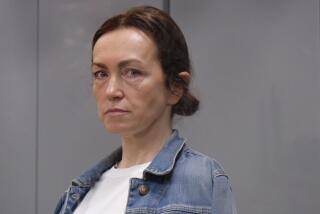Soccer Death Revelations Sign of More Open Soviet Press : Journalism: Sports newspaper outlines government cover-up of incident in which 66 were reported killed in Moscow.
MOSCOW — On Oct. 21, 1982, a three-sentence item appeared on an inside page of Pravda, the official Communist Party newspaper, about an incident that occurred the night before during a game at one of the city’s soccer stadiums, Luzhniki. It reported that 66 spectators were killed in violence that Moscow’s Procurator General, a combination police chief and district attorney, blamed on drunken hooligans.
Not another word appeared about the incident in the Soviet press for almost seven years. In June, reacting to the violence at a soccer game in Sheffield, England, that claimed 95 lives, Sovietsky Sport, the Soviet Union’s daily sports newspaper, revived the Moscow tragedy in a four-page special report called “Black Day at Luzhniki.”
After two months of investigation, a team of reporters revealed that many more persons than reported might have been killed, that several official agencies--including the Procurator’s office--attempted to conceal that fact by burying multiple bodies in each grave and that the incident was caused not by drunken hooligans, but by the stadium police.
According to the newspaper, the police, eager to clear the stadium on a cold, snowy night although time remained in a game between Moscow Spartak and Haarlem of the Netherlands, began ushering spectators up the icy steps toward the only exit that was open. When Moscow Spartak scored to tie the game with 20 seconds remaining, spectators who had filed out of the stadium rushed back inside, trampling others who were leaving.
“It was reported that 66 were killed,” said Valeri Kudriavtsev, editor-in-chief of Sovietsky Sport, during a meeting last week in his office with several Western sports reporters. “There’s no way that could be right. But let’s say that 66 people did die. That’s no longer the issue. The issue is that everything was covered up.”
The Procurator’s office did not want it uncovered. Only important government officials have the number to the white telephone on Kudriavtsev’s desk. Known officially as the Kremlin Connection and unofficially as “the heart attack phone,” it rang often during the investigation.
But no one ordered him to kill the story. Perhaps even more significant as a barometer of changes in Soviet journalism, Kudriavtsev, although he knew the story would make him unpopular with government leaders, did not kill it.
Not so long ago, no Soviet newspaper editor would have dared to be so bold for fear of losing his job. But under President Mikhail Gorbachev’s policy of glasnost , or openness, journalists are free to examine virtually every aspect of Soviet life, including sports.
In the past, Sovietsky Sport could be considered hard-hitting only when criticizing performances of a player or a coach. The newspaper did not deal with issues, such as performance-enhancing drugs or alcoholism or the limited future for a Soviet athlete after his or her retirement.
On the day he chatted with Western reporters, Kudriavtsev proudly showed them the front page of that day’s newspaper, which reported that a Soviet world champion track cyclist had been suspended after testing positive for a stimulant. Five years before, he said, no Soviet newspaper would have reported that.
He dug into recent back issues and produced articles critical of the layers of bureaucracy at the state-controlled sports committee, its unabashed embrace of commercialism, and health care in the country--including a commentary about the effect of nuclear testing on both the environment and people in some regions.
“We’ve changed, the subjects we cover have changed,” he said. “We dig a little deeper into stories than we used to; we’ve been a lot more honest.”
The change has come so rapidly that he admits to sometimes being a little dazed. Sovietsky Sport has published so many controversial articles with so little response from the officials that he wonders whether there ever was censorship or whether the newspaper was guilty of censoring itself.
“There are two kinds of censorship,” he said. “One says that you can’t print state and military secrets. The main body for that kind of censorship is about half a mile from here.”
He pointed out the window toward Dzerzhinsky Square, headquarters of the KGB.
“Then there was the kind of censorship that we had, which was not direct censorship,” he said. “It was a self-preservation instinct on the part of the editors and the journalists. Let’s say there’s a wall in front of you. You don’t go and butt your head against it. That’s not because you’re afraid. That’s because you’re smart.”
Sovietsky Sport might have been too smart for its own good, he said.
When the Procurator complained that the newspaper should have investigated the soccer deaths when they occurred, not seven years later, Kudriavtsev, who did not become the editor until a year later, could not argue.
“I think the journalists here made a mistake,” he said.
Asked if there are boundaries now, he said, “I think we can write about anything we want.”
But he said that some of his reporters still are shackled by their pre- glasnost training.
“The journalists themselves are not quite ready to write about some things,” he said. “Here, in this office, I told my writers to delve into things frankly and openly. But everyone has within himself this complex about what he can and cannot write. It will take more time.”
As an example of frankness, one of the reporters, after the meeting with Kudriavtsev ended, complained that the editor had delayed publication of an article on the feelings of Lithuanian athletes as their republic seeks independence from the Soviet Union. The Soviet media in general have reverted to their former one-sided style in reporting the Lithuanian story. But the reporter said he could think of no other recent instance when a story had been withheld because of political reasons.
Most editors in the United States would be uncomfortable with Sovietsky Sport’s relationship with the state-controlled sports committee, Goskomsport. As a division of the committee, the newspaper is financed by Goskomsport. But Kudriavtsev pointed out that, with a daily circulation of 6 million, the newspaper contributes more than $3 million a year to Goskomsport.
“They realize that the stronger we are, the more money they get,” he said.
Still, he would prefer for the newspaper to be independent as long as its purpose, stated as funding athletes when it was established in 1924, did not change.
“We dream of independence,” he said. “However, the problem isn’t whether to stand on our own and be honest. We have already proved we can do that.
“But we didn’t found this paper. This paper was founded to subsidize sports. I want to continue to help sports develop. I don’t want that kind of independence. I want independence from the bureaucrats who try to tell us what to do.”
The newspaper also would be open to conflict-of-interest charges in the U.S. because one of its reporters is a member of Goskomsport’s anti-doping commission.
Kudriavtsev laughed when confronted with that. He said the newspaper got a break on the story about the cyclist who tested positive for a stimulant because the Sovietsky Sport reporter was at the commission meeting when the incident was discussed.
“She’s our spy there,” he said.
More to Read
Sign up for Essential California
The most important California stories and recommendations in your inbox every morning.
You may occasionally receive promotional content from the Los Angeles Times.









